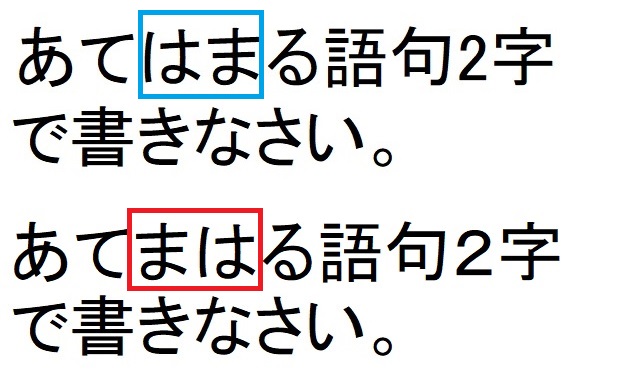
Fukushima Board of Education admits mistake, but it’s hard to imagine it made any difference.
Fukushima recently held its entrance exam for public prefectural high schools, and obviously all of the candidates were trying to answer the questions correctly. That’s usually a lot harder to do, though, when the question itself isn’t correct.
Last Thursday, the Fukushima Prefectural board of Education put out a statement to explain that a misprint in the instructions for a question in the social studies section had been brought to their attention. After confirming that they had in fact goofed up, the board has decided to give all candidates credit for answering the question correctly, regardless of how they actually answered it on the test.
That seems like a fair thing to do. After all, if the question is worded in a way that’s confusing or misleading, you can’t really expect kids to still get the right answer, can you?
Well, maybe you can. The question involved a section from Japan’s constitution, with one section underlined. Students were supposed to look at the underlined section, then write the specialized political term that applies to the underlined portion. The question even gave them a bit of a hint, specifying that the term is made up of two kanji characters.
Written in Japanese correctly, “Please write the applicable two-kanji word” looks like this:
The question students actually saw written in their tests, though, looked like this:
See the difference?
Two hiragana characters have had their order switched. Taken as a set, あてはまる, read “atehamaru,” means “applicable” or “appropriate.”
On the other hand, what was actually written in the test, あてまはる, “atemaharu,” doesn’t have any meaning at all.
Here’s the thing, though. Atehamaru is a phrase that shows up in tests all the time, pretty much in any permutation of “Select the appropriate answer.” It’s a word that students know they’re going to see over and over during their entrance exam before the test even starts, and because atemaharu isn’t a word, it should have been pretty obvious not only that the atemaharu was a typo, but also that it was supposed to be atehamaru.
▼ It’s sort of like if I asked “Which of these is a dog? Please pick the corectr photo.” That typo isn’t going to throw anyone off so badly that they pick the lobster.
Because of that, most Japanese Twitter reactions have been sort of shocked that everyone is getting credit for the question because of the atehamaru/atemaharu slip-up, with comments such as:
“Everyone gets a free point on the test just for that?”
“Makes no sense at all.”
“There’s lucky, and then there’s too lucky.”
“They’re being way too soft on them.”
“I honestly wouldn’t have even noticed the typo.”
“I think it took me 50,000 tries to read it as anything other than atehamaru.”
A few commenters also wondered about the possibility of that free point boosting the score of a student who answered the question incorrectly just high enough to secure admission to a school’s last available seat by nature of compensation for the typo, perhaps denying the slot to someone who had answered the question correctly and thus won’t be seeing their own score raise any higher because of the board’s decision. That would, though, mean that the two students had had equal scores before the free point though, so it would have been an incredibly small margin between the two applicants.
In any case, it’s probably safe to say that the board will be adding an extra round of proofreading checks to its test next year.
Source: Fukushima Prefectural Board of Education, Yomiuri Shimbun via Livedoor News via Jin, Twitter/@livedoornews
Top image: Pakutaso
Insert images: SoraNews24, Pakutaso (1, 2)
● Want to hear about SoraNews24’s latest articles as soon as they’re published? Follow us on Facebook and Twitter!







 With entrance exams looming, “ads that only students can see” appear in Tokyo train stations
With entrance exams looming, “ads that only students can see” appear in Tokyo train stations Bizarre English test in Japan asks students about winged vegetables, launches new meme
Bizarre English test in Japan asks students about winged vegetables, launches new meme Man kicked out of Japan’s national college entrance exam for improper mask-wearing technique
Man kicked out of Japan’s national college entrance exam for improper mask-wearing technique Japanese rail company lets teens ride for free on super stressful entrance exam days
Japanese rail company lets teens ride for free on super stressful entrance exam days Teen gets perfect score on Japan’s college entrance history exam with crazy-detailed notes【Pics】
Teen gets perfect score on Japan’s college entrance history exam with crazy-detailed notes【Pics】 Ramen restaurant’s English menu prices are nearly double its Japanese ones, denies discriminating
Ramen restaurant’s English menu prices are nearly double its Japanese ones, denies discriminating Top Japanese cosplayer Enako returns to Comiket after 6 years, creates mayhem with admirers
Top Japanese cosplayer Enako returns to Comiket after 6 years, creates mayhem with admirers Here’s what our bachelor writers ate over the New Year’s holiday in Japan
Here’s what our bachelor writers ate over the New Year’s holiday in Japan Nearly one in ten young adults living in Japan isn’t ethnically Japanese, statistics show
Nearly one in ten young adults living in Japan isn’t ethnically Japanese, statistics show Tokyo train stations giving out awesome giant Pokémon cards, but you’ll want to hurry
Tokyo train stations giving out awesome giant Pokémon cards, but you’ll want to hurry Things get heavy with the Gold Lucky Bag from Village Vanguard
Things get heavy with the Gold Lucky Bag from Village Vanguard Mr. Sato visited Black Thunder’s new factory, but was mostly captivated by their sukajan jackets
Mr. Sato visited Black Thunder’s new factory, but was mostly captivated by their sukajan jackets Starbucks Japan adds a Shine Muscat Grape Frappuccino to the menu for a limited time
Starbucks Japan adds a Shine Muscat Grape Frappuccino to the menu for a limited time Never work with animals: Outtakes from Japanese delivery company’s adorable black cat ad【Video】
Never work with animals: Outtakes from Japanese delivery company’s adorable black cat ad【Video】 Kyoto samurai house wants to share its history of seppuku, torture and gold coins with visitors
Kyoto samurai house wants to share its history of seppuku, torture and gold coins with visitors Starbucks Japan ready to get Year of the Horse started with adorable drinkware and plushies【Pics】
Starbucks Japan ready to get Year of the Horse started with adorable drinkware and plushies【Pics】 Japanese beef bowl chain Sukiya’s 2026 Smile Box lucky bag basically pays for itself
Japanese beef bowl chain Sukiya’s 2026 Smile Box lucky bag basically pays for itself Hayao Miyazaki says Happy New Year to Studio Ghibli fans with new art for Year of the Horse
Hayao Miyazaki says Happy New Year to Studio Ghibli fans with new art for Year of the Horse Cup Noodle tries an authentic Jiro-style ramen, but something’s not quite right
Cup Noodle tries an authentic Jiro-style ramen, but something’s not quite right The best Starbucks Japan Frappuccinos we want to drink again in 2026
The best Starbucks Japan Frappuccinos we want to drink again in 2026 We revisited Sweets Paradise after a decade to see if Japan’s dessert buffet still delivers
We revisited Sweets Paradise after a decade to see if Japan’s dessert buffet still delivers That time Seiji called JASRAC to ask why he didn’t get paid royalties for his song being on TV
That time Seiji called JASRAC to ask why he didn’t get paid royalties for his song being on TV We found possibly the quietest Japanese-style hotel in Tokyo’s bustling Shinjuku district
We found possibly the quietest Japanese-style hotel in Tokyo’s bustling Shinjuku district Pizza Hut Japan’s hot lucky bags are perfect for a New Year’s pizza party
Pizza Hut Japan’s hot lucky bags are perfect for a New Year’s pizza party Japan’s oldest largetooth sawfish in captivity back on display in Mie Prefecture
Japan’s oldest largetooth sawfish in captivity back on display in Mie Prefecture 7-Eleven Japan starts new temporary luggage storage service in over 300 branches
7-Eleven Japan starts new temporary luggage storage service in over 300 branches Disillusionment at Tsukiji’s tourist-target prices led us to a great ramen restaurant in Tokyo
Disillusionment at Tsukiji’s tourist-target prices led us to a great ramen restaurant in Tokyo Starbucks teams up with 166-year-old Kyoto doll maker for Year of the Horse decorations【Photos】
Starbucks teams up with 166-year-old Kyoto doll maker for Year of the Horse decorations【Photos】 Tokyo considering law requiring more trash cans following litter increase in heavily touristed area
Tokyo considering law requiring more trash cans following litter increase in heavily touristed area Tokyo’s Tsukiji sushi neighborhood asks tour groups to stay away for the rest of the month
Tokyo’s Tsukiji sushi neighborhood asks tour groups to stay away for the rest of the month Tokyo event lets you travel back in time, for free, to celebrate 100 years since Showa era start
Tokyo event lets you travel back in time, for free, to celebrate 100 years since Showa era start Japan may add Japanese language proficiency, lifestyle classes to permanent foreign resident requirements
Japan may add Japanese language proficiency, lifestyle classes to permanent foreign resident requirements Sanrio theme park in Japan announces plans to expand into a Sanrio resort
Sanrio theme park in Japan announces plans to expand into a Sanrio resort Stamina-destroying “Paralysis Noodles” are Tokyo’s newest over-the-top ramen innovation
Stamina-destroying “Paralysis Noodles” are Tokyo’s newest over-the-top ramen innovation Survey asks foreign tourists what bothered them in Japan, more than half gave same answer
Survey asks foreign tourists what bothered them in Japan, more than half gave same answer Japan’s human washing machines will go on sale to general public, demos to be held in Tokyo
Japan’s human washing machines will go on sale to general public, demos to be held in Tokyo Japan’s deadliest food claims more victims, but why do people keep eating it for New Year’s?
Japan’s deadliest food claims more victims, but why do people keep eating it for New Year’s? We deeply regret going into this tunnel on our walk in the mountains of Japan
We deeply regret going into this tunnel on our walk in the mountains of Japan Studio Ghibli releases Kodama forest spirits from Princess Mononoke to light up your home
Studio Ghibli releases Kodama forest spirits from Princess Mononoke to light up your home Major Japanese hotel chain says reservations via overseas booking sites may not be valid
Major Japanese hotel chain says reservations via overseas booking sites may not be valid Put sesame oil in your coffee? Japanese maker says it’s the best way to start your day【Taste test】
Put sesame oil in your coffee? Japanese maker says it’s the best way to start your day【Taste test】 No more using real katana for tourism activities, Japan’s National Police Agency says
No more using real katana for tourism activities, Japan’s National Police Agency says Starbucks Japan reveals new sakura drinkware collection, inspired by evening cherry blossoms
Starbucks Japan reveals new sakura drinkware collection, inspired by evening cherry blossoms Updated cherry blossom forecast shows extra-long sakura season for Japan this year
Updated cherry blossom forecast shows extra-long sakura season for Japan this year Public high school in Japan’s Gifu Prefecture will no longer take student absences into account for entrance applications
Public high school in Japan’s Gifu Prefecture will no longer take student absences into account for entrance applications Tokyo Medical University accused of dropping women’s entrance exam scores 10-20 percent each year
Tokyo Medical University accused of dropping women’s entrance exam scores 10-20 percent each year The number of entrance exam takers at a top public high school in Okayama falls short, all pass
The number of entrance exam takers at a top public high school in Okayama falls short, all pass Awesome Japanese elementary school teacher rewards kids who use independent learning on his tests
Awesome Japanese elementary school teacher rewards kids who use independent learning on his tests Which one is former Nissan CEO Carlos Ghosn? Japanese students surprised by test question
Which one is former Nissan CEO Carlos Ghosn? Japanese students surprised by test question Students go nearly a year without textbooks after teacher forgets to hand them out
Students go nearly a year without textbooks after teacher forgets to hand them out Tokyo middle school leaflet asks students to write down, turn in their social media passwords
Tokyo middle school leaflet asks students to write down, turn in their social media passwords Foreign English teacher in Japan calls student’s ability garbage, says it was an “American joke”
Foreign English teacher in Japan calls student’s ability garbage, says it was an “American joke” Elementary and junior high students speak out on Japan’s strangest school rules
Elementary and junior high students speak out on Japan’s strangest school rules Tokyo schoolboy assumes other boy’s identity for six months, attends classes at top high school
Tokyo schoolboy assumes other boy’s identity for six months, attends classes at top high school Japanese high schools stop asking students to specify their gender on application forms
Japanese high schools stop asking students to specify their gender on application forms Japanese elementary school kid says 12 x 25 = 300, teacher doesn’t say he’s answered correctly
Japanese elementary school kid says 12 x 25 = 300, teacher doesn’t say he’s answered correctly Can you write the alphabet properly? According to Japanese teachers, probably not
Can you write the alphabet properly? According to Japanese teachers, probably not The reason why Japanese students don’t pronounce English properly
The reason why Japanese students don’t pronounce English properly First-grader’s math test accidentally turns into treatise on confusing Japanese linguistics
First-grader’s math test accidentally turns into treatise on confusing Japanese linguistics
Leave a Reply